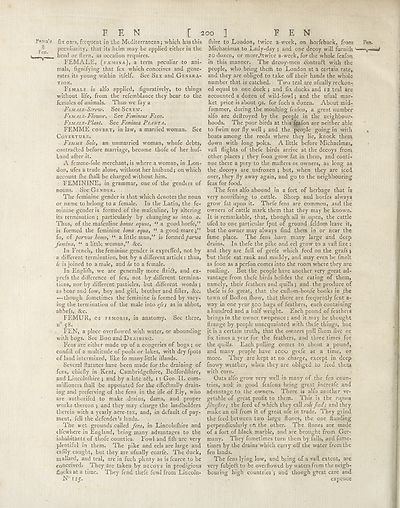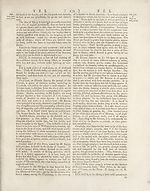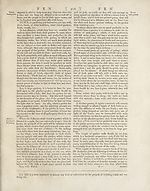Encyclopaedia Britannica > Volume 7, ETM-GOA
(222) Page 200 - FEN
Download files
Complete book:
Individual page:
Thumbnail gallery: Grid view | List view

FEN r 200 1 FEN
fix oars, frequent in the Mediterranean; which has this
peculiarity , that its helm may be applied either in the
head or ftern, as occafion requires.
FEMALE, (f^emina), a term peculiar to ani¬
mals, fignifying that fex which conceives and gene¬
rates its young within itfelf. See Sex and Genera¬
tion.
Female is alfo applied, figuratively, to things
without life, from the refemblance they bear to the
females of animals. Thus we fay a
FEMJLE-Screw. See Screw.
Female-Flower. ■ See Femineus Flos.
Female-Plant. See Feminea Planta.
FEMME covert, in law, a married woman. See
Coverture.
Femme Sole, an unmarried woman, whofe debts,
contra&ed before marriage, become thofe of her huf-
band after -it.
A femme-fole merchant, is where a woman, in Lon¬
don, ufes a trade alone, without her hulband; on which
account (he (hall be charged without him.
FEMININE, in grammar, one of the genders of
nouns. See Gender.
The feminine gender is that which denotes the noun
or name to belong to a female. In the Latin, the fe¬
minine gender is formed of the mafeuline, by altering
its termination; particularly by changing ar into a.
Thus, of the mafeuline bonus equus, “ a good horfe,”
is formed the feminine Iona equay “ a good mare
fo, of parvus homo, “ a little man,” is formed parva
ftemina, “ a little woman,” &c.
In French, the feminine gender is expreffed, not by
a different termination, but by a different article: thus,
le is joined to a male, and la to a female.
In Englifh, we are generally more ftri&, and ex-
prefs the difference of fex, not by different termina¬
tions, nor by different particles, but different words;
as boar and fow, boy and girl, brother and fifter, &c.
—though fometimes the feminine is formed by vary¬
ing the termination of the male into ejs •, as in abbot,
abbefs, &c.
FEMUR, os femoris, in anatomy. See there,
n° 58.
FEN, a place overflowed with water, or abounding
with bogs. See Bog and Draining.
Fens are either made up of a congeries of bogs ; or
confift. of a multitude of pools or lakes, with dry fpots
of land intermixed, like fo many little iflands.
Several ffatutes have been made for ,the draining of
fens, chiefly in Kent, Cambridgeffu're, Bedfordlhire,
and Lincolnfhire ; and by a late aft, 11 Geo. 11. com-
miffioners (hall be appointed for the effectually drain¬
ing and preferving of the fens in the ifle -of Ely, who
are authorifed to make -drains, dams, and proper
works thereon ; and they may charge the landholders
therein with a yearly acre-tax, and, in default of .pay¬
ment, fell the defender’s lands.
The wet grounds called fens, in Lincolnfhire and
elfewhere in England, bring many advantages to the
inhabitants of thofe counties. Fowl and fi(h are very
plentiful in them. The pike and eels are large and
eafily caught, but they are ufually coarfe. The duck,
mallard, and teal, are in fuch plenty as is fcarce to be
conceived.- They are taken by decoys in prodigious
flocks at a time. They fend thefe fowl from Lincoln-
N° 125.
(hire to London, twice a-week, on horfeback, from Fen.
Michaelmas to Lady-day ; and one decoy will furnifh ' ;
20 dozen, or more,*twice a-week, for the whole feafon
in this manner. The decoy-men cbntraft with the
people, who bring them to London at a certain rate,
and they are obliged to take off their hands the whole
number that is catched. Two teal are ufually reckon¬
ed equal to one duck ; and fix ducks and 12 teal are
accounted a dozen of wild-fowl; and the ufual mar¬
ket price is about 9s. for fuch a dozen. About mid-
fummer, during the moulting feafon, a great number
alfo are deftroyed by the people in the neighbour¬
hoods. The poor birds at this (ieafon are neither able
to fwim nor fly well; and the people going in with v
boats among the reeds where they lie, knock them
down with long poles. A little before Michaelmas,
vaft. flights of thefe birds arrive at the decoys from
other places; they foon grow fat in them, and conti¬
nue there a ptey to the mailers or owners, as long as
the decoys are unfrozen ; but, when they are iced
over, they fly away again, and go to the neighbouring
feas for food.
The fens alfo abound in a fort of herbage that is
very nourifhing to cattle. Sheep and horfes always
grow' fat upon it. Thefe fens are common, and the
owners of cattle mark them that they may be known.
It is remarkable, that, though all is open, the cattle
ufed to one particular fpo.t of ground feldom leave it,
but the owner may always find them in or near the
fame place. The fens have many large and deep
drains. In thefe the pike and eel grow to a vaft fize :
and they are full of geefe which feed on the grafs j
but thefe eat rank and muddy, and may even be fmelt
as foon as a perfon comes into the room where they are
roafting. But the people have another very great ad¬
vantage from thefe birds befides the eating of them,
namely, their feathers and quills ; and the produce of
thefe is fo great, that the cuftom-houfe books in the
town of Boilon {how, that there are frequently fent a-
way in one year 300 bags of feathers, each containing
ahundred and a half weight. Each pound of feathers
brings in the owner twopence ; and it may be thought
flrange by people unacquainted with thefe things, but
it is a certain truth, that the owners pull them five or
fix times a year for the feathers, and three times for
the quills. Each pulling comes to about a pound,
and many people have 1000 geefe at a time, or
more. They are kept at no charge, except in deep
fnowy weather, when they are obliged to feed them
with corn.
Oats alfo grow very well in many of the fen coun¬
tries, and in good feafons bring great increafe and
advantage to the owners. There is alfo another ve¬
getable of great profit to them. This is the rapum
JUveJlre; the feed of which they call cok feed; and they
make an oil from it of great ufe in trade. They grind
the feed between two large ftones, the one (landing
perpendicularly on the other. The Hones are made
of a fort of black marble, and are brought from Ger¬
many. They fometimes turn them by fails, and fome¬
times by the drains which carry off the water from the
fen lands.
The fens lying low, and being of a vaff extent, are
very fubjett to be overflowed by waters from the neigh¬
bouring high countries ; and though great care and
expcnce
fix oars, frequent in the Mediterranean; which has this
peculiarity , that its helm may be applied either in the
head or ftern, as occafion requires.
FEMALE, (f^emina), a term peculiar to ani¬
mals, fignifying that fex which conceives and gene¬
rates its young within itfelf. See Sex and Genera¬
tion.
Female is alfo applied, figuratively, to things
without life, from the refemblance they bear to the
females of animals. Thus we fay a
FEMJLE-Screw. See Screw.
Female-Flower. ■ See Femineus Flos.
Female-Plant. See Feminea Planta.
FEMME covert, in law, a married woman. See
Coverture.
Femme Sole, an unmarried woman, whofe debts,
contra&ed before marriage, become thofe of her huf-
band after -it.
A femme-fole merchant, is where a woman, in Lon¬
don, ufes a trade alone, without her hulband; on which
account (he (hall be charged without him.
FEMININE, in grammar, one of the genders of
nouns. See Gender.
The feminine gender is that which denotes the noun
or name to belong to a female. In the Latin, the fe¬
minine gender is formed of the mafeuline, by altering
its termination; particularly by changing ar into a.
Thus, of the mafeuline bonus equus, “ a good horfe,”
is formed the feminine Iona equay “ a good mare
fo, of parvus homo, “ a little man,” is formed parva
ftemina, “ a little woman,” &c.
In French, the feminine gender is expreffed, not by
a different termination, but by a different article: thus,
le is joined to a male, and la to a female.
In Englifh, we are generally more ftri&, and ex-
prefs the difference of fex, not by different termina¬
tions, nor by different particles, but different words;
as boar and fow, boy and girl, brother and fifter, &c.
—though fometimes the feminine is formed by vary¬
ing the termination of the male into ejs •, as in abbot,
abbefs, &c.
FEMUR, os femoris, in anatomy. See there,
n° 58.
FEN, a place overflowed with water, or abounding
with bogs. See Bog and Draining.
Fens are either made up of a congeries of bogs ; or
confift. of a multitude of pools or lakes, with dry fpots
of land intermixed, like fo many little iflands.
Several ffatutes have been made for ,the draining of
fens, chiefly in Kent, Cambridgeffu're, Bedfordlhire,
and Lincolnfhire ; and by a late aft, 11 Geo. 11. com-
miffioners (hall be appointed for the effectually drain¬
ing and preferving of the fens in the ifle -of Ely, who
are authorifed to make -drains, dams, and proper
works thereon ; and they may charge the landholders
therein with a yearly acre-tax, and, in default of .pay¬
ment, fell the defender’s lands.
The wet grounds called fens, in Lincolnfhire and
elfewhere in England, bring many advantages to the
inhabitants of thofe counties. Fowl and fi(h are very
plentiful in them. The pike and eels are large and
eafily caught, but they are ufually coarfe. The duck,
mallard, and teal, are in fuch plenty as is fcarce to be
conceived.- They are taken by decoys in prodigious
flocks at a time. They fend thefe fowl from Lincoln-
N° 125.
(hire to London, twice a-week, on horfeback, from Fen.
Michaelmas to Lady-day ; and one decoy will furnifh ' ;
20 dozen, or more,*twice a-week, for the whole feafon
in this manner. The decoy-men cbntraft with the
people, who bring them to London at a certain rate,
and they are obliged to take off their hands the whole
number that is catched. Two teal are ufually reckon¬
ed equal to one duck ; and fix ducks and 12 teal are
accounted a dozen of wild-fowl; and the ufual mar¬
ket price is about 9s. for fuch a dozen. About mid-
fummer, during the moulting feafon, a great number
alfo are deftroyed by the people in the neighbour¬
hoods. The poor birds at this (ieafon are neither able
to fwim nor fly well; and the people going in with v
boats among the reeds where they lie, knock them
down with long poles. A little before Michaelmas,
vaft. flights of thefe birds arrive at the decoys from
other places; they foon grow fat in them, and conti¬
nue there a ptey to the mailers or owners, as long as
the decoys are unfrozen ; but, when they are iced
over, they fly away again, and go to the neighbouring
feas for food.
The fens alfo abound in a fort of herbage that is
very nourifhing to cattle. Sheep and horfes always
grow' fat upon it. Thefe fens are common, and the
owners of cattle mark them that they may be known.
It is remarkable, that, though all is open, the cattle
ufed to one particular fpo.t of ground feldom leave it,
but the owner may always find them in or near the
fame place. The fens have many large and deep
drains. In thefe the pike and eel grow to a vaft fize :
and they are full of geefe which feed on the grafs j
but thefe eat rank and muddy, and may even be fmelt
as foon as a perfon comes into the room where they are
roafting. But the people have another very great ad¬
vantage from thefe birds befides the eating of them,
namely, their feathers and quills ; and the produce of
thefe is fo great, that the cuftom-houfe books in the
town of Boilon {how, that there are frequently fent a-
way in one year 300 bags of feathers, each containing
ahundred and a half weight. Each pound of feathers
brings in the owner twopence ; and it may be thought
flrange by people unacquainted with thefe things, but
it is a certain truth, that the owners pull them five or
fix times a year for the feathers, and three times for
the quills. Each pulling comes to about a pound,
and many people have 1000 geefe at a time, or
more. They are kept at no charge, except in deep
fnowy weather, when they are obliged to feed them
with corn.
Oats alfo grow very well in many of the fen coun¬
tries, and in good feafons bring great increafe and
advantage to the owners. There is alfo another ve¬
getable of great profit to them. This is the rapum
JUveJlre; the feed of which they call cok feed; and they
make an oil from it of great ufe in trade. They grind
the feed between two large ftones, the one (landing
perpendicularly on the other. The Hones are made
of a fort of black marble, and are brought from Ger¬
many. They fometimes turn them by fails, and fome¬
times by the drains which carry off the water from the
fen lands.
The fens lying low, and being of a vaff extent, are
very fubjett to be overflowed by waters from the neigh¬
bouring high countries ; and though great care and
expcnce
Set display mode to:
![]() Universal Viewer |
Universal Viewer | ![]() Mirador |
Large image | Transcription
Mirador |
Large image | Transcription
Images and transcriptions on this page, including medium image downloads, may be used under the Creative Commons Attribution 4.0 International Licence unless otherwise stated. ![]()
| Encyclopaedia Britannica > Encyclopaedia Britannica > Volume 7, ETM-GOA > (222) Page 200 - FEN |
|---|
| Permanent URL | https://digital.nls.uk/189124115 |
|---|
| Attribution and copyright: |
|
|---|
| Description | Ten editions of 'Encyclopaedia Britannica', issued from 1768-1903, in 231 volumes. Originally issued in 100 weekly parts (3 volumes) between 1768 and 1771 by publishers: Colin Macfarquhar and Andrew Bell (Edinburgh); editor: William Smellie: engraver: Andrew Bell. Expanded editions in the 19th century featured more volumes and contributions from leading experts in their fields. Managed and published in Edinburgh up to the 9th edition (25 volumes, from 1875-1889); the 10th edition (1902-1903) re-issued the 9th edition, with 11 supplementary volumes. |
|---|---|
| Additional NLS resources: |
|

